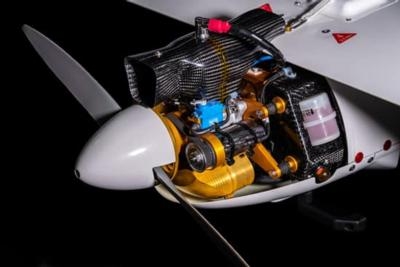Only University To Have Access To The Long-Range Professional UAV
Embry-Riddle Aeronautical University recently became the only university to acquire the Penguin C – one of the most sophisticated long-endurance, long-range professional unmanned aircraft systems on the market today – specifically for flight training.

The arrival of three Penguin C aircraft earlier this year instantly transformed Embry-Riddle, already the world’s largest unmanned aircraft systems (UAS) educator, serving some 1,500 students university-wide, into an unmatched powerhouse provider of both UAS flight- and simulation-based training.
Embry-Riddle’s acquisition of the Penguin C’s also opened the door for missions controlled from multiple ground-based stations, called “remote-split operations,” as well as flight beyond the operator’s visual line of sight. The aircraft have applications for fighting wildfires, border patrol, search and rescue, oil pipeline and utility inspections, environmental assessments and military surveillance.
All those applications suggest an array of career paths for Embry-Riddle graduates trained to fly Penguin C’s. The burgeoning commercial drone industry is projected to generate more than $82 billion for the U.S. economy and, by 2025, it could support as many as 100,000 new jobs, according to a White House estimate.
With a 10.8-foot wingspan, the new fixed-wing Penguin C aircraft are capable of flying up to 20 hours over a 60-mile range while carrying electrical, optical and infrared camera sensors. They promise a leg up for professional UAS pilots-in-training at Embry-Riddle, said Professor Mike Wiggins, chair of Aeronautical Science on the Daytona Beach Campus.
Embry-Riddle’s Unmanned Aircraft Systems Science program, established in 2011 as the first of its kind in the nation, encompasses three flight courses and one simulator course.

“Students currently learn to fly small fixed-wing survey platforms, and beginning in 2020, the military-grade Penguin C aircraft,” Wiggins said. “The goal is to ensure our graduates have the skills they need to run a successful business or operation using all types of UAS in a safe, responsible manner.”
At a time when hobbyists can obtain a small drone operator’s license by taking a written exam, said Professor Alan Stolzer, dean of the College of Aviation, “The goal of Embry-Riddle’s program is to train highly qualified, professional UAS pilots who have deep knowledge of best practices in mission planning, data collection, data delivery and safety protocols.”
Two recent graduates with unique industry experience are playing a key role in the game-changing transformation of Embry-Riddle’s UAS program.
Shane Aldridge (’15) and Mike “Zeb” Zebehazy (’10), who both worked for leading aerospace and defense company Textron Systems, were recruited by Embry-Riddle to help run the university’s Penguin C fleet, based on their knowledge of a similar platform called the Aerosonde. They are working with Alexander Mirot, associate professor of Aeronautical Science, whose Air Force experience provided him with deep knowledge of unmanned aircraft such as the MQ-9 Reaper.
Last September, Aldridge and Zebehazy spent a month in Latvia, training to fly Penguin C’s before the aircraft arrived at Embry-Riddle. “We learned how to pack the parachute that helps the aircraft land safely, and how to maintain it and fly it,” said Aldridge, now a UAS Flight Supervisor at Embry-Riddle.
For long-endurance missions, Aldridge explained, “it’s all about the sensor you’re carrying on the aircraft.” The sensor on Embry-Riddle’s Penguin C’s, stabilized by a gimbal, carries either an electro-optical camera with a 30-power zoom lens for daytime use or a long-wave infrared sensor that captures images in darkness.
Currently, the Penguin C’s are being tested over controlled airspace near Bunnell, Fla., about 25 miles north of the Daytona Beach Campus. Zebehazy, UAS Maintenance and Inventory Manager, said the university is working on applications for FAA waivers that would allow students to fly the Penguin C’s over the Bunnell field via a remote-control operation in Daytona Beach. Because the aircraft have a digital datalink, the goal is to fly them through a network connection, Aldridge noted.
If the FAA waivers are approved, he said, Embry-Riddle would become the only organization other than the military with remote-split UAS capability.
The Penguin C’s, purchased from the UAV factory, will become accessible to students in spring 2020.
(Images provided with ERAU news release)
 ANN's Daily Aero-Term (04.20.24): Light Gun
ANN's Daily Aero-Term (04.20.24): Light Gun Aero-News: Quote of the Day (04.20.24)
Aero-News: Quote of the Day (04.20.24) ANN's Daily Aero-Linx (04.21.24)
ANN's Daily Aero-Linx (04.21.24) Aero-News: Quote of the Day (04.21.24)
Aero-News: Quote of the Day (04.21.24) ANN's Daily Aero-Term (04.21.24): Aircraft Conflict
ANN's Daily Aero-Term (04.21.24): Aircraft Conflict




